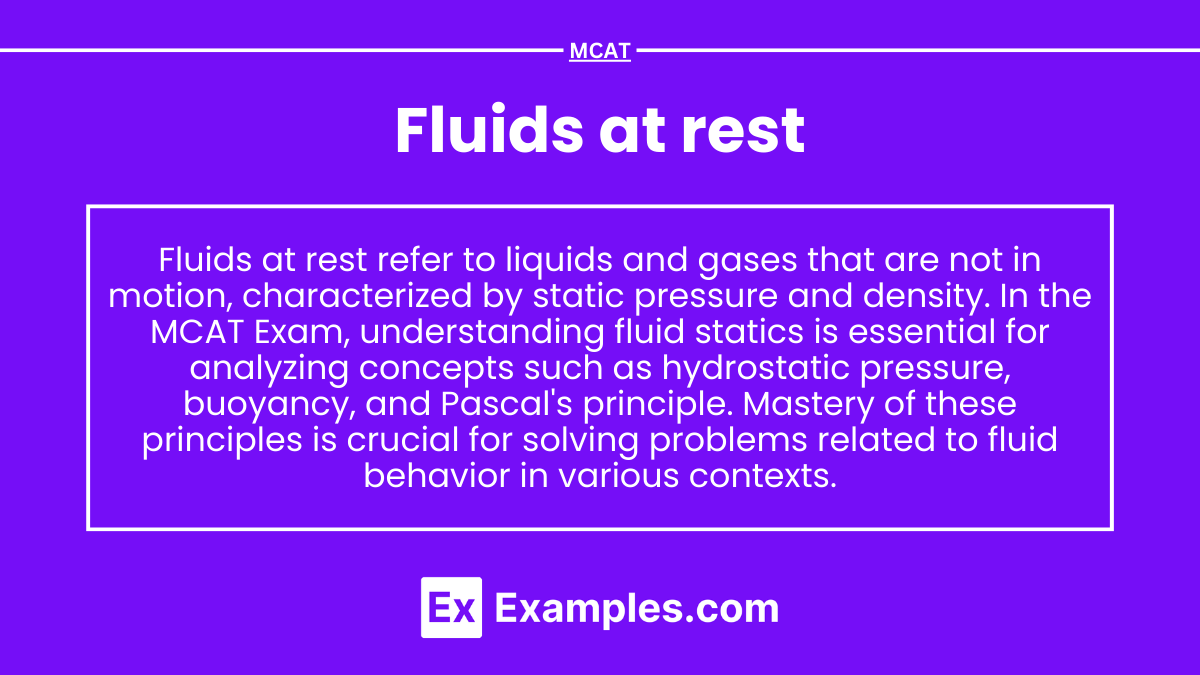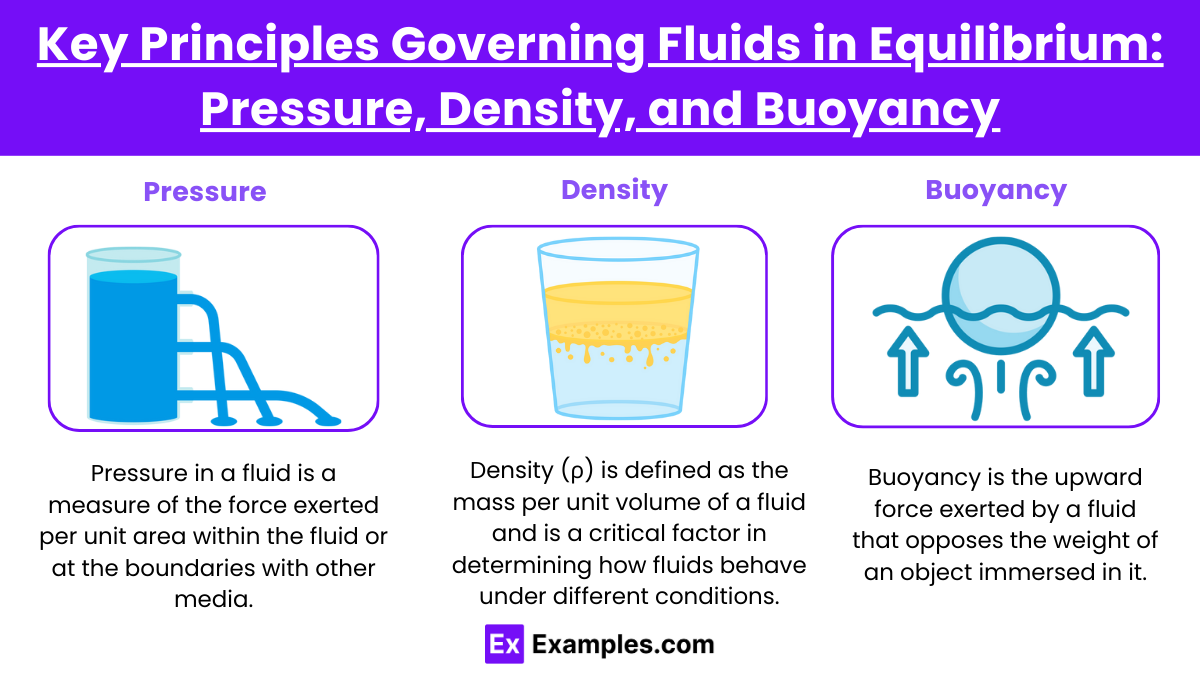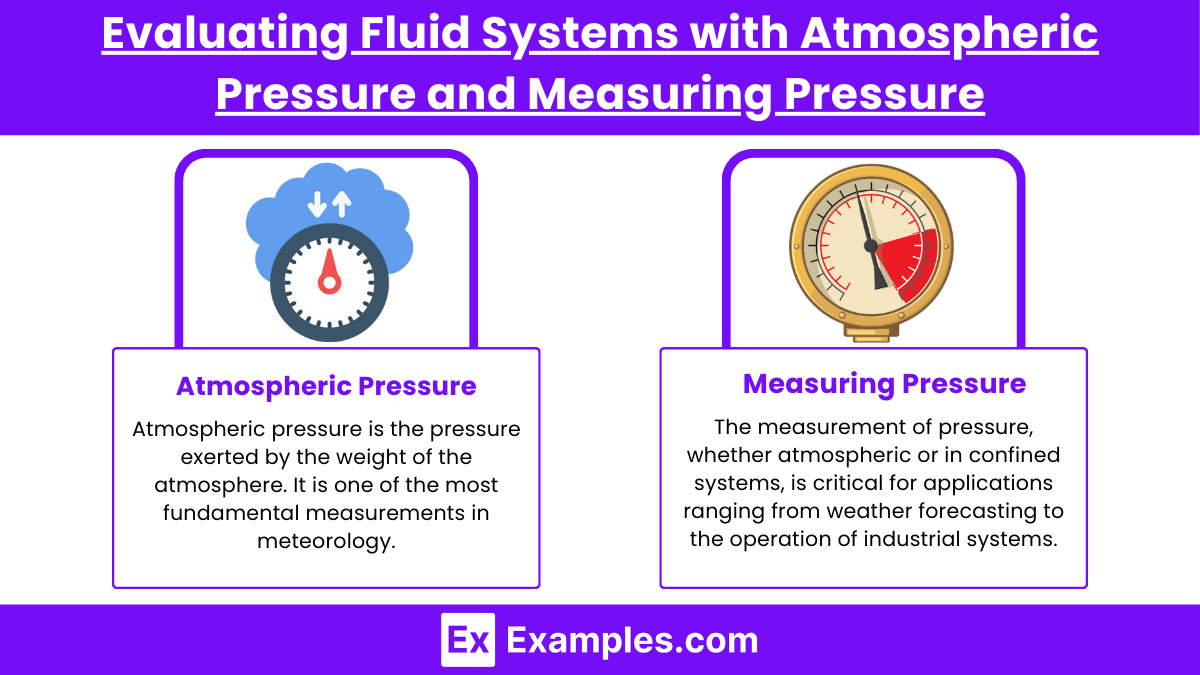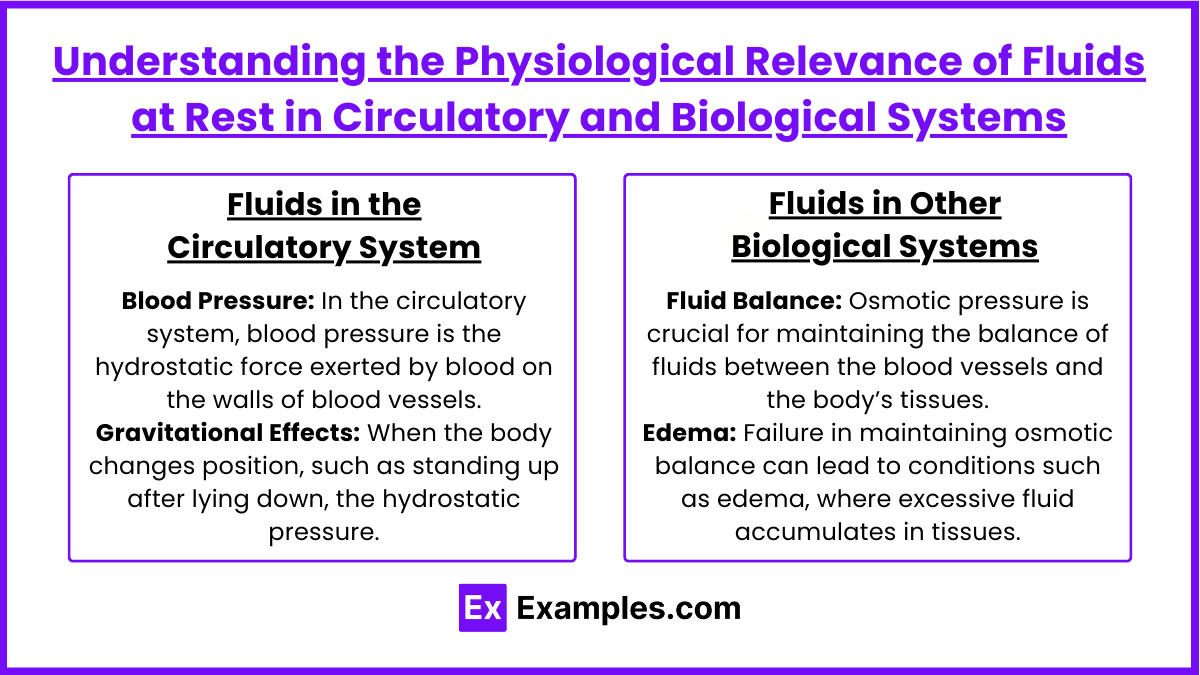Fluids at rest are a crucial topic in physics and biochemistry, playing a vital role in understanding pressure, buoyancy, and fluid dynamics. On the MCAT, you’ll explore hydrostatic pressure, Pascal’s principle, and Archimedes’ principle. Mastering concepts like fluid density, surface tension, and the behavior of fluids in confined spaces is essential, as these topics are integral to solving problems in both physical sciences and biological systems.
Learning Objectives
In studying "Fluids at Rest" for the MCAT, you should learn to identify the key principles governing fluids in equilibrium, including pressure, density, and buoyancy. Understand how pressure varies with depth according to Pascal’s principle and apply the concept of hydrostatic pressure in problem-solving. Analyze the behavior of objects submerged in a fluid using Archimedes’ principle to determine buoyant forces. Evaluate fluid systems involving atmospheric pressure and the measurement of pressure using barometers and manometers. Develop problem-solving strategies for applying these concepts to real-world scenarios, such as fluid-filled compartments in the human body. Additionally, understand the physiological relevance of fluids at rest in circulatory systems and fluid pressure in different biological environments.
Key Principles Governing Fluids in Equilibrium: Pressure, Density, and Buoyancy
Pressure
Pressure in a fluid is a measure of the force exerted per unit area within the fluid or at the boundaries with other media (such as the walls of a container or another fluid). The fundamental characteristics of pressure in fluids are:
Isotropic Nature: In a fluid at rest, pressure at a point is the same in all directions, which is why changes in pressure can propagate through the fluid uniformly.
Depth Dependency: Pressure in a fluid increases with depth due to the weight of the fluid above. This is described by the hydrostatic pressure equation:
P = P0+ρgh
where P is the pressure at depth h, P0 is the pressure at the surface, ρ is the fluid density, g is the acceleration due to gravity, and h is the depth below the surface.
Density
Density (ρ) is defined as the mass per unit volume of a fluid and is a critical factor in determining how fluids behave under different conditions.
Variability: The density of fluids can vary with temperature and pressure. For gases, density decreases as temperature increases or pressure decreases, according to the ideal gas law. For liquids, density typically decreases with temperature but is generally less sensitive to changes in pressure.
Stratification: Differences in density can lead to stratification in fluids, where layers of different densities form, such as in oceans and atmospheres.
Buoyancy
Buoyancy is the upward force exerted by a fluid that opposes the weight of an object immersed in it. This principle is governed by Archimedes’ Principle, which states:
Archimedes' Principle: Any object, wholly or partly immersed in a fluid, will be buoyed up by a force equal to the weight of the fluid displaced by the object.
Fb = ρgV
where Fb is the buoyant force, ρ is the density of the fluid, g is the gravitational acceleration, and V is the volume of fluid displaced by the object.
Variation of Pressure with Depth and Pascal’s Principle
In a fluid at rest, the pressure at any given point is due to the weight of the fluid above that point. This leads to several important observations:
Pressure Increases with Depth: As you go deeper into a fluid, the pressure increases. This is because the weight of the fluid above the point in question adds to the pressure exerted at that depth.
Formula for Pressure Variation: The pressure at a depth h in a fluid of constant density ρ is given by:
P = P0+ρgh
Here, P0 is the pressure at the surface, ρ is the density of the fluid, g is the acceleration due to gravity, and h is the depth below the surface. This relationship assumes that the fluid is incompressible and that its density does not change with depth, which is a good approximation for liquids but not for gases.
Implications: This principle is crucial for designing submersible vehicles and understanding the behavior of atmospheric pressure with altitude, where the opposite effect occurs—pressure decreases as altitude increases.
Pascal’s Principle
Pascal's Principle, named after the French mathematician and physicist Blaise Pascal, is a fundamental concept in the mechanics of fluids and states that:
Pressure Applied to an Enclosed Fluid Is Transmitted Undiminished to Every Portion of the Fluid and to the Walls of Its Container:
This principle explains how hydraulic systems, such as car brakes and hydraulic lifts, work. When a force is applied to a small area of fluid in a confined space, the pressure increase is transmitted throughout the entire fluid, allowing for a multiplied force to be exerted in a different part of the system.
For example, in a hydraulic lift, applying a small force to a small piston results in a larger force exerted by a larger piston, which can lift heavier loads. This happens because the pressure exerted by the smaller piston is transmitted undiminished through the hydraulic fluid to the larger piston.
Evaluating Fluid Systems with Atmospheric Pressure and Measuring Pressure
Atmospheric Pressure
Atmospheric pressure is the pressure exerted by the weight of the atmosphere. It is one of the most fundamental measurements in meteorology and plays a crucial role in various fluid systems:
Effects on Fluid Systems:
Open Systems: In systems open to the atmosphere, such as ponds or open tanks, the atmospheric pressure is exerted on the surface of the fluid. This external pressure needs to be considered when calculating the total pressure at any point in the fluid.
Closed Systems: In closed systems, like sealed tanks or pressure vessels, the internal pressure can significantly differ from the atmospheric pressure. The understanding of atmospheric pressure is crucial when designing such systems to ensure they can withstand the differential pressure without failing.
Altitude Variations: Atmospheric pressure decreases with increasing altitude. This variation affects everything from the boiling point of liquids (which decreases at higher altitudes due to lower atmospheric pressure) to the design of aircraft cabins and engines.
Measuring Pressure
The measurement of pressure, whether atmospheric or in confined systems, is critical for applications ranging from weather forecasting to the operation of industrial systems. There are several instruments and techniques used to measure pressure:
1. Barometer:
Mercury Barometer: Consists of a glass tube filled with mercury, inverted into a mercury reservoir. Atmospheric pressure pushes the mercury up the tube, and the height of the mercury column provides a direct measurement of atmospheric pressure. A standard atmosphere (at sea level) typically supports a mercury column about 760 mm high.
Aneroid Barometer: Uses a small, flexible metal box called an aneroid cell, which expands and contracts with changes in pressure. These movements are magnified by mechanical linkages to give a pressure reading, often more convenient for portable use than mercury barometers.
2. Manometer:
U-Tube Manometer: Measures the difference in pressure between the atmosphere and a fluid system. It consists of a U-shaped tube partially filled with a liquid (often mercury or water), with one end open to the atmosphere and the other connected to the fluid system. The difference in liquid level between the two arms of the tube corresponds to the pressure difference.
Digital Manometer: Offers precise electronic measurement of pressure through sensors that convert pressure into an electrical signal, which is then displayed on a digital readout.
3. Pressure Gauges:
Bourdon Tube: A common tool for measuring pressure in closed systems, such as in plumbing or HVAC systems. It consists of a curved tube that straightens out as pressure increases. The movement is linked to a needle on a dial to indicate pressure.
Digital Pressure Gauges: Provide digital readings of pressure, offering high accuracy and easy integration with other digital systems for monitoring and control purposes.
Understanding the Physiological Relevance of Fluids at Rest in Circulatory and Biological Systems
Fluids in the Circulatory System
The circulatory system, consisting of the heart, blood vessels, and blood, can be analyzed through the principles of fluid dynamics to understand how blood moves, how pressures are maintained, and what happens when these processes are disrupted.
Hydrostatic Pressure:
Blood Pressure: In the circulatory system, blood pressure is the hydrostatic force exerted by blood on the walls of blood vessels. It varies throughout the system, being highest in the arteries and lowest in the veins.
Gravitational Effects: When the body changes position, such as standing up after lying down, the hydrostatic pressure due to gravity causes blood to pool in the legs. The body must adjust (through mechanisms like vasoconstriction and increased heart rate) to maintain blood flow to vital organs, especially the brain.
Osmotic Pressure:
Fluid Balance: Osmotic pressure is crucial for maintaining the balance of fluids between the blood vessels and the body’s tissues. This pressure, driven by solute concentrations (mainly salts and proteins), helps regulate the exchange of fluids across capillary walls, ensuring that nutrients, gases, and wastes are properly exchanged.
Edema: Failure in maintaining osmotic balance can lead to conditions such as edema, where excessive fluid accumulates in tissues, often due to protein imbalances or capillary damage.
Fluids in Other Biological Systems
Beyond the circulatory system, the principles governing fluids at rest also apply to various other biological systems and processes.
Cellular and Interstitial Fluids:
Homeostasis: The balance of fluids within and between cells is essential for homeostasis. Cellular functions depend on the proper fluid environment, regulated by osmotic and hydrostatic pressures.
Nutrient and Waste Transport: Fluids at rest in cellular and extracellular matrices facilitate the diffusion of nutrients into cells and the removal of metabolic wastes, driven by concentration gradients and pressure differentials.
Cerebrospinal Fluid (CSF):
Cushioning and Protection: CSF surrounds and cushions the brain and spinal cord, providing a buffer against physical shocks. The fluid's hydrostatic pressure helps it perform this role effectively.
Nutrient Distribution and Waste Removal: CSF also plays a crucial role in distributing nutrients to the brain and removing wastes, acting much like the blood in the circulatory system but within the central nervous system.
Examples
Example 1: Water in a Glass
When water is poured into a glass and allowed to settle, it remains at rest, with the surface flat and horizontal. The pressure within the water increases with depth due to the weight of the water above, even though the fluid is stationary. This illustrates how pressure varies within a fluid at rest depending on depth.
Example 2: Atmospheric Pressure
The air surrounding us behaves like a fluid at rest. The atmospheric pressure at sea level is higher than at higher altitudes because the air closer to the Earth's surface has more air above it, exerting a force downward. This explains why pressure decreases as altitude increases, even though the air appears stationary.
Example 3: Hydraulic Systems
In a car's braking system, hydraulic fluid is at rest within the system when the brakes are not applied. When pressure is applied through the brake pedal, the fluid transmits force to the brake pads. The behavior of the fluid while at rest allows pressure to be evenly distributed, making hydraulic systems highly efficient for force transmission.
Example 4: Oil in a Tank
In an oil storage tank, the oil remains at rest until it is drained. The pressure at the bottom of the tank is higher than at the top because the oil above exerts force on the lower layers. This is an example of how fluids at rest generate pressure that increases with depth, which is critical for determining tank durability.
Example 5: Swimming Pool Water
The water in a swimming pool is typically at rest unless disturbed. The pressure experienced by a diver at the bottom of the pool is greater than at the surface due to the weight of the water above. This difference in pressure, while the water is at rest, is a classic demonstration of how fluid pressure changes with depth in a static fluid.
Practice Questions
Question 1
Which of the following statements is true regarding fluids at rest?
A) Fluids at rest have no pressure exerted on them.
B) The pressure in a fluid at rest increases with depth.
C) Fluids at rest flow continuously in all directions.
D) The density of a fluid does not affect the pressure.
Correct Answer: B) The pressure in a fluid at rest increases with depth.
Explanation: In a fluid at rest, the pressure experienced at any point within the fluid increases with depth due to the weight of the fluid above it. This principle is fundamental in understanding fluid statics. As you go deeper into a fluid, more fluid mass is above that point, contributing to greater pressure. Options A and C are incorrect because fluids at rest do exert pressure and do not flow continuously. Option D is also incorrect, as the density of a fluid directly influences the pressure at a given depth.
Question 2
What is the primary factor affecting the pressure exerted by a fluid at rest in a container?
A) The shape of the container.
B) The volume of the fluid.
C) The depth of the fluid.
D) The temperature of the fluid.
Correct Answer: C) The depth of the fluid.
Explanation: The pressure exerted by a fluid at rest is primarily determined by the depth of the fluid. The deeper you go in a fluid, the more weight of the fluid above that point contributes to the pressure experienced. While the shape of the container, volume, and temperature can affect fluid behavior, they do not primarily influence the pressure at a given depth in a static fluid.
Question 3
Which of the following scenarios demonstrates the principle of hydrostatic pressure in fluids at rest?
A) A straw drawing liquid upward.
B) A water balloon bursting when squeezed.
C) A fish swimming at varying depths in a lake.
D) A diver experiencing increased pressure as they descend underwater.
Correct Answer: D) A diver experiencing increased pressure as they descend underwater.
Explanation: As a diver descends underwater, they experience increased pressure due to the weight of the water above them, illustrating the concept of hydrostatic pressure in fluids at rest. This principle states that pressure increases with depth in a static fluid. Options A and B involve dynamic fluid scenarios, while option C describes a fish swimming but does not directly illustrate the effect of hydrostatic pressure on a stationary fluid.






